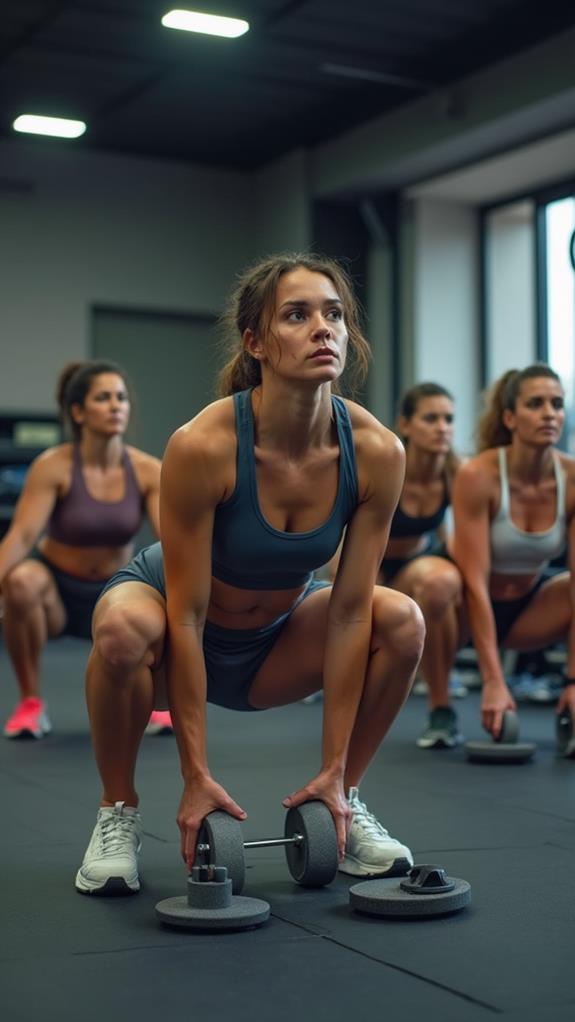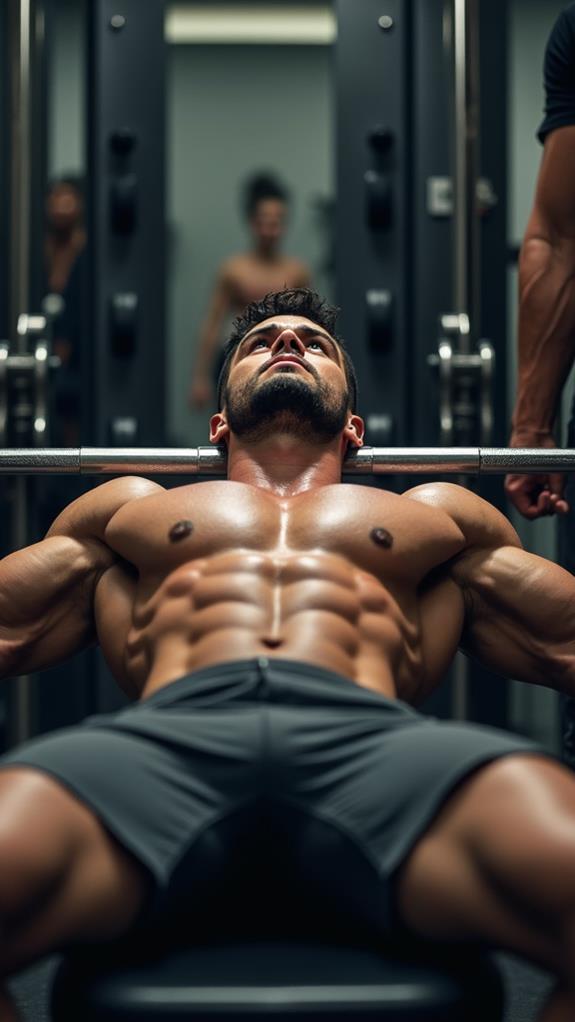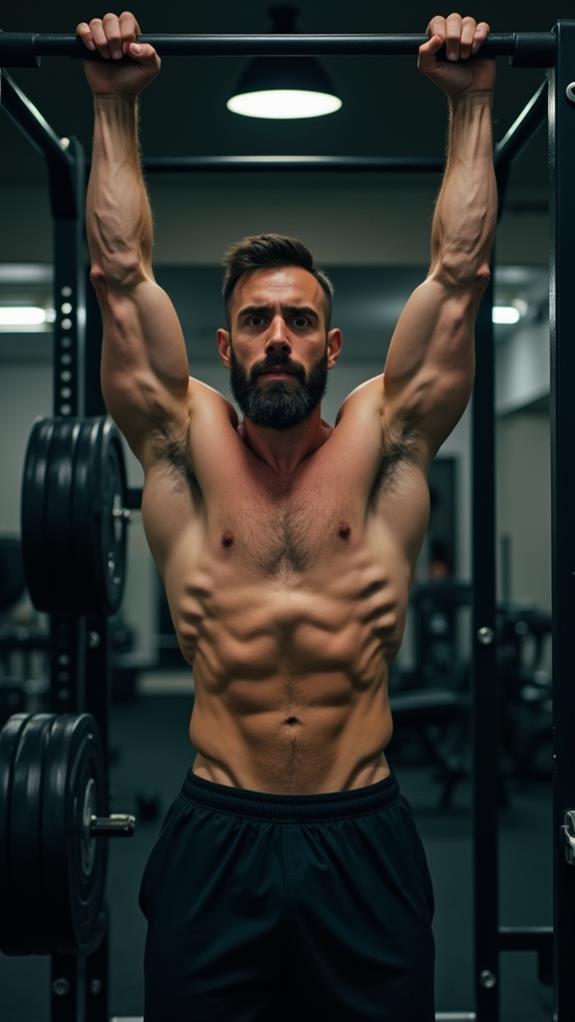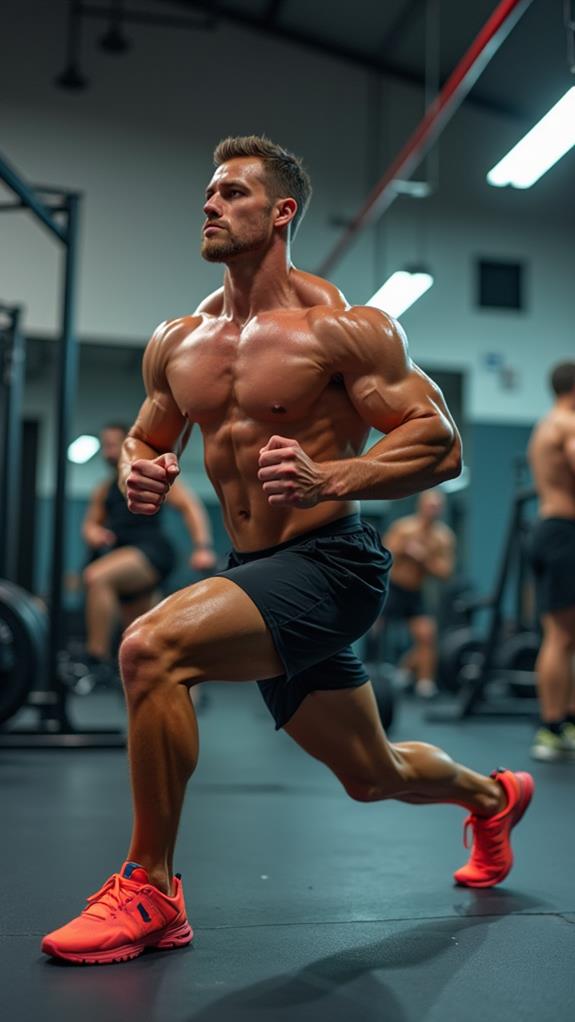If you're looking to bulk up your muscles and gain weight, it's crucial to focus on a well-rounded exercise regimen. Incorporating exercises like squats and deadlifts can greatly enhance your lower body strength, while movements such as the bench press and pull-ups build upper body mass. However, it's not just about lifting heavy; understanding the right combination of these eight exercises can make a real difference in your results. What's the best way to structure your workouts to guarantee you're maximizing your gains? Let's explore this further.
Squats

When it comes to bulking up muscles, squats are a powerhouse exercise you can't afford to skip. They work your legs, glutes, and core all at once, giving you a strong foundation.
You'll find that squat variations, like front squats and jump squats, can keep your workouts exciting and challenging. Each variation targets different muscle groups, helping you build strength in various ways.
One of the fantastic squat benefits is that they boost your overall athletic performance. Whether you're running, jumping, or playing sports, stronger legs will help you excel.
Plus, squats can improve your balance and flexibility, making everyday movements easier and safer. When you squat, you also engage your core, which means you're getting a mini workout for your abs too!
To get started, focus on perfecting your form. Keep your feet shoulder-width apart, and lower your body as if you're sitting in a chair.
You'll want to push through your heels and keep your chest up. As you get comfortable, try adding weights or different squat variations to level up your training.
Deadlifts
Deadlifts are a fundamental lift that can greatly enhance your muscle growth and strength. They work multiple muscles at once, including your back, legs, and core, making them super effective.
The best part? You can try different deadlift variations, like sumo deadlifts or Romanian deadlifts, to keep things fresh and target specific muscles.
When you start deadlifting, you'll notice some big deadlift benefits. First, it helps increase your overall strength, which means you can lift heavier weights in other exercises, too!
Plus, it improves your posture and stability, which is great for everyday activities.
Don't worry if you're new to deadlifting; just focus on using the right form to avoid injury. Start with lighter weights and gradually increase as you feel more comfortable.
You can also ask a trainer for tips or watch videos to perfect your technique.
Remember to warm up before you start and cool down afterward to keep your muscles happy.
So grab that barbell, and let's get lifting! You're on your way to building those muscles and gaining weight in a healthy way.
Keep pushing yourself, and enjoy the process!
Bench Press

The bench press is one of the most effective exercises for building upper body strength and muscle mass. When you perform the bench press, you target your chest, shoulders, and triceps, which helps you gain strength and increase your muscle size.
One of the best bench press benefits is that it can be done with free weights or a barbell, making it easy to adjust the weight to fit your level.
To mix things up and keep your workouts exciting, you can try bench press variations. For instance, the incline bench press targets the upper chest, while the decline bench press focuses on the lower chest.
You might also want to use dumbbells instead of a barbell; this can help improve your balance and coordination.
Overhead Press
The overhead press is an awesome exercise that can really help you build strength in your shoulders and arms.
When you use proper form, you'll not only see better results but also reduce the risk of injury.
Plus, there are many variations you can try to keep your workouts exciting and effective!
Benefits of Overhead Press
Overhead presses offer a powerhouse workout for building upper body strength and improving overall stability. When you perform this exercise, you're not just lifting weights; you're activating multiple muscle groups, especially in your shoulders and arms. This means you'll see gains in muscle activation that can help you lift heavier in other exercises too!
One of the best benefits of the overhead press is the boost it gives to your shoulder stability. By working your shoulder muscles, you're making them stronger and more resilient, which helps prevent injuries during other workouts. Strong shoulders are key to performing daily activities more easily, like lifting boxes or reaching for something high up.
Additionally, incorporating overhead presses into your routine can enhance your core strength. As you press the weights overhead, your core engages to keep your body stable, giving you a double whammy of benefits!
Proper Form Techniques
Lifting weights overhead effectively hinges on mastering proper form techniques. First, stand with your feet shoulder-width apart and grip the barbell just outside of your shoulders. Keep your core tight and your chest up. As you lift the bar, press it straight up over your head, ensuring your elbows remain slightly in front of the bar. This helps protect your shoulders and keeps your balance strong.
Remember to engage your legs; they help support the lift! As you lower the bar back to your shoulders, control the movement. It's all about that smooth motion—no jerking or sudden drops.
After your workout, focus on muscle recovery. Stretching and proper rest are essential, but don't forget your nutrition tips! Fuel your body with protein-rich foods to help those muscles grow. Foods like chicken, eggs, or beans are great options.
Practice these techniques regularly, and you'll see improvement in no time. Remember, good form not only helps prevent injuries but also maximizes your gains.
Variations for Strength Training
Many lifters find that incorporating variations of the overhead press can considerably enhance their strength training routine. This exercise is a great compound exercise that targets multiple muscle groups, helping you build overall strength. You can try different versions like the seated overhead press or the push press to keep things exciting and challenge your body.
By using these exercise variations, you'll engage various muscles, making your workouts more effective. Remember to practice progressive overload by gradually increasing the weight you lift. This approach will help you reach your training goals faster.
It's also essential to balance your routine with isolation exercises for specific muscles, ensuring well-rounded development. Pay attention to your training frequency and allow for proper muscle recovery between workouts.
Don't forget your nutrition strategies! Eating the right foods will fuel your workouts and support muscle growth. If you're following workout splits, be sure to include overhead press variations regularly.
With dedication and the right plan, you'll see fantastic results in no time. Keep pushing yourself, and enjoy the journey of becoming stronger!
Pull-Ups

Pull-ups are a powerhouse exercise that targets multiple muscle groups, making them a staple in any strength training routine. When you do pull-ups, you engage your back, shoulders, and arms, which helps build overall strength and muscle mass. Plus, they're great for improving your grip strength, an essential part of many exercises.
To get started, find a pull-up bar and grab it with both hands, palms facing away from you. Make sure your hands are about shoulder-width apart. As you pull yourself up, focus on squeezing your shoulder blades together and keeping your core tight. This muscle engagement is vital for getting the most out of the exercise.
If you can't do a full pull-up yet, don't worry! You can start with assisted pull-ups or negative pull-ups to build your strength gradually.
Don't forget to breathe! Inhale as you lower yourself down and exhale when you pull up. Aim for a few sets of 5 to 10 reps, and watch how your strength improves over time. With consistency and effort, you'll be on your way to bulking up and achieving your fitness goals!
Bent-Over Rows
Bent-over rows are an excellent compound exercise that effectively targets your upper back, lats, and biceps. This move is perfect if you want to build strength and muscle engagement in your upper body.
To start, grab a pair of dumbbells or a barbell. You can even use resistance bands if you're looking for a lighter option.
Stand with your feet shoulder-width apart, slightly bend your knees, and hinge at your hips, keeping your back straight. Hold the weights with your palms facing each other. As you pull the weights towards your waist, squeeze your shoulder blades together. Remember to keep your elbows close to your body. It's all about form!
Aim for 3 sets of 8-12 reps, resting between sets. You'll feel those muscles working hard, and that's a good sign! Not only does this exercise help you bulk up, but it also improves your posture and balance.
Lunges

Lunges are an awesome exercise for building strong legs and glutes!
They not only help you get toned but also improve your balance and stability.
Let's explore the benefits of lunges, how to do them correctly, and some fun variations you can try to keep things interesting!
Benefits of Lunges
Incorporating lunges into your workout routine can markedly enhance your muscle-building efforts. Lunges are fantastic for muscle activation, especially in your legs and glutes. When you perform lunges, you're not just working out one muscle group; you're engaging multiple muscles at once. This means you'll build strength and size more effectively.
One of the best benefits of lunges is their ability to improve your balance. As you step forward or backward into a lunge, you're training your body to stabilize itself. This balance improvement helps in many daily activities, making you feel more agile and coordinated.
Plus, better balance can reduce your risk of injury during workouts and sports.
Lunges can also be easily modified to fit your fitness level. You can start with bodyweight lunges and gradually add weights as you get stronger. This makes lunges a great option for everyone, whether you're a beginner or more advanced.
Proper Form Techniques
To get the most out of lunges, it's vital to maintain proper form. Start by standing tall with your feet hip-width apart. As you step forward, make sure your knee doesn't extend past your toes. This helps protect your knees and keeps your balance steady. Lower your body until both knees are at about a 90-degree angle. Your back knee should hover just above the ground, while your torso remains upright. Engaging your core will give you extra stability.
Remember to switch legs after each rep, and don't rush through the movement. Slow and controlled lunges will help you build muscle effectively. Also, focus on your breathing; inhale as you lower your body and exhale as you return to the starting position.
After your workout, prioritize muscle recovery by incorporating rest and proper nutrition strategies into your routine. Eating protein-rich foods will help repair and grow your muscles. Staying hydrated is also important, so drink plenty of water.
With consistent practice and the right form, you'll see great improvements in your strength and muscle growth. Keep pushing yourself, and enjoy the journey!
Variations to Try
When it comes to lunges, experimenting with variations can keep your workouts fresh and target different muscle groups. This is key for muscle hypertrophy, which helps you grow stronger and bulk up.
Start with the traditional forward lunge, stepping forward and bending both knees. It's simple but effective! Next, try reverse lunges, stepping back instead of forward. This variation helps protect your knees while still giving those leg muscles a great workout.
After that, why not add some weights? Holding dumbbells while doing lunges increases resistance, making your muscles work harder. You can also try side lunges, stepping to the side instead of forward. This targets your inner and outer thighs, giving you a well-rounded workout.
For an extra challenge, try walking lunges. They keep your body moving and can really pump up your heart rate, adding a cardio element to your resistance training.
Dips
Dips are one of the most effective exercises for building upper body strength and muscle mass, targeting your triceps, chest, and shoulders. When you perform dips, you not only work on strength but also enjoy impressive dips benefits like improved stability and coordination.
It's a fantastic way to pack on muscle, especially if you want to bulk up. You can spice things up by trying different dips variations. Standard dips are great, but you can also try bench dips, where you use a bench or chair for support. This version is easier and perfect for beginners.
If you're looking for a challenge, consider adding weight with a dip belt or even a weighted vest. To perform a dip, grab the bars or the edge of a bench, lower your body by bending your elbows, then push back up.
Remember to keep your body straight and engage your core. Aim for three sets of 8–12 reps for best results. Incorporating dips into your workout routine won't only help you gain weight but also boost your confidence as you see those muscles grow!



0 Comments